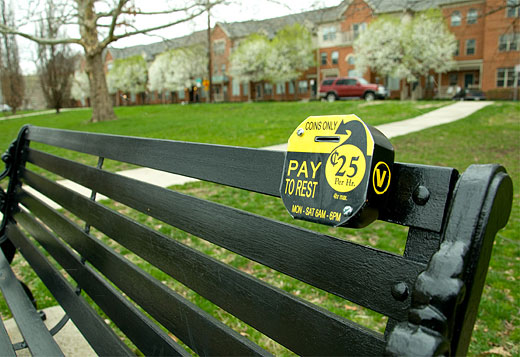
Pay to Rest by Vinchen is a simple-enough intervention, adding a suggestive coin-operated mechanism to a city bench.
It may be a one-liner, but it caught my eye a couple days ago, the photo sat on my desktop, and now this morning upon reading Amherstburg’s idea to introduce pay-per-use fees to soccer fields, baseball diamonds, etc., it made me curious about the priorities of a city when such significant money can go into certain forms of maintenance, but then shift other services to another kind of access model.
I’ll admit I’m making a bit of a leap here, but if benches were indeed pay-per-use, would it result in better kept parks? If an entire city shifted to a pay-per-use model, would things get any better? What would be the first bit of infrastructure to collapse? If the entire city operated on a subscription service model, would there be any positive change?
[via Wooster Collective]

Amherstburg depresses me more and more lately.
I mean, lets make families who have little money pay for their outdoor recreation…good idea :(
Pay-for-use would be fine, as long as taxes are reduced lock-step. If we actually paid the real cost of the infrastructure we used on a daily basis, whether it be hockey arenas, roads, sidewalks, etc. etc, that are currently supported through municipal tax dollars, citizens would be more conscious about the money that is spent to support that infrastructure.
Charlottetown just got a report stating that the local arena needs $40 million in upgrades. IMO, only a subset of citizens use that facility (players, fans, etc.) If the arena is not fiscally feasible without tax dollars, then it is not feasible.
Can you imagine a world where sprawl actually cost the real cost? Man oh man —
Slippery slope here. What must be determined is whether a municipal expense aids the public welfare. Do arenas aid the public welfare? It could be argued that if we didn’t have arenas (or soccer fields, baseball diamonds, etc.) that there would be more children breaking into your Lexus just for something to do. Or they would become morbidly obese playing their Xbox and acting as a heavier (pun intended!) cost to our health care system.
Does road infrastructure constitute an aid to public welfare? Sure, they encourage the flight to the suburbs, draining our core of life and making us fat, but they are also what our buses and bikes ride on daily. They are also what the ambulance will use to get to our kids when they get hit by a car, because they couldn’t afford the pay-per-use parks and set up a road hockey game in the streets.
A clear definition of the public good must be established and entrenched in our collective psyche. Is that even possible?
After checking this stuff out I’m very curious about how pay-per-use price will be calculated and how it will be policed. Will it cost $10 for a group of 5 to enter the soccer field thats surrounded by a 10 ft tall barb-wired fence that has one subway style revolving steel gate?
Because to me this sounds like the continuing results of suburban gentrification. Since even if you can afford to play their often, the people who can easily afford it will most likely hold a kinds of social dominance over it, causing others with their used equipment and scruffy outfits to feel too uncomfortable to play there.
It’s depressing to understand that required tax dollar spending involves such a concentration on hardscape infrastructure, and yet beyond that, so many of the things that make a city a better place to live are considered extras, discretionary spending, etc.
A definition of the public good should involve a consideration of the triple bottom line (people, planet, profit), with a notion of the long now involved in every decision.
What could Windsor look like in five years if the city started thinking in 100 year increments?